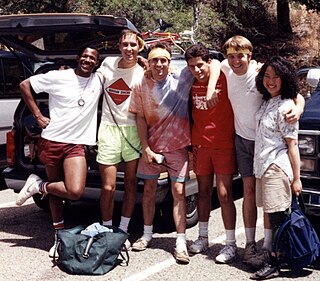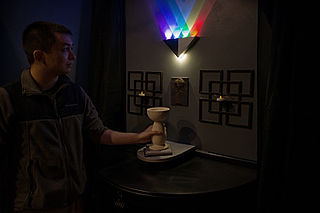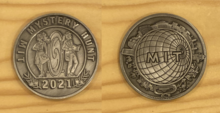
A crossword is a word game consisting of a grid of black and white squares, into which solvers enter words or phrases ("entries") crossing each other horizontally ("across") and vertically ("down") according to a set of clues. Each white square is typically filled with one letter, while the black squares are used to separate entries. The first white square in each entry is typically numbered to correspond to its clue.
A puzzle is a game, problem, or toy that tests a person's ingenuity or knowledge. In a puzzle, the solver is expected to put pieces together in a logical way, in order to arrive at the correct or fun solution of the puzzle. There are different genres of puzzles, such as crossword puzzles, word-search puzzles, number puzzles, relational puzzles, and logic puzzles. The academic study of puzzles is called enigmatology.

Nonograms, also known as Hanjie, Paint by Numbers, Picross, Griddlers, and Pic-a-Pix are picture logic puzzles in which cells in a grid must be colored or left blank according to numbers at the edges of the grid to reveal a hidden picture. In this puzzle, the numbers are a form of discrete tomography that measures how many unbroken lines of filled-in squares there are in any given row or column. For example, a clue of "4 8 3" would mean there are sets of four, eight, and three filled squares, in that order, with at least one blank square between successive sets.

Murder mystery games are a genre of party games. One of the players secretly plays a murderer, whilst other players must determine who among them is the criminal. Murder mystery games often involve the actual 'murders' of guests throughout the game, or open with a 'death' and have the rest of the time devoted to investigation.

Flavor text is text for action figure character backgrounds, video games, playing cards, or within the pages of a role-playing game's rulebook. While appropriate to the product's or game's story concept, it usually has no effect on the mechanics of the game, but instead serves to add realism or characterization or lore to the item in question. Flavor text is often the last text on a card or on the rear of a toy card or package, and is usually printed in italics or written between quotes to distinguish it from game-affecting text.

The Game is a non-stop 24- to 48-hour treasure hunt, puzzlehunt or road rally that has run in the San Francisco Bay and Seattle areas. Its teams use vans rigged with power and Internet access and drive hundreds of miles from puzzle site to puzzle site, overcoming often outrageous physical and mental challenges along the way, usually with no sleep. Teams in games have been required to walk around the roof of the Space Needle, find a puzzle hidden in a live rat, and circulate a petition to ban dihydrogen monoxide from local ecosystems while dressed in superhero outfits.

A scavenger hunt is a game in which the organizers prepare a list defining specific items, which the participants seek to gather or complete all items on the list, usually without purchasing them. Usually participants work in small teams, although the rules may allow individuals to participate. The goal is to be the first to complete the list or to complete the most items on that list. In variations of the game, players take photographs of listed items or be challenged to complete the tasks on the list in the most creative manner. A treasure hunt is another name for the game, but it may involve following a series of clues to find objects or a single prize in a particular order.

Treasure: In Search of the Golden Horse is a treasure hunting puzzle published in 1984 by the Intravision production company. It was conceived as a story-based contest by filmmaker Sheldon Renan similar in concept to that of Kit Williams' book Masquerade. The puzzle was presented in two formats, one in an elaborate book illustrated by Jean-Francois Podevin and published by Warner Books, and the other a direct-to-video motion picture filmed by Renan and starring Doryan Dean with Elisha Cook, Jr. in a supporting role. Voice-over narration was provided by actor Richard Lynch with music by composer Jesse Frederick. The film was first aired on cable television and subsequently sold on VHS, Capacitance Electronic Disc, and Laserdisc formats by Vestron Video.
Perplex City was an alternate reality game (ARG) created by Mind Candy, a London-based developer in 2005. Adrian Hon was the producer, designer and director of the game's first and only season, in which players searched for "The Receda Cube", an artifact of spiritual significance to the inhabitants of a fictional metropolis known as "Perplex City" which had great scientific value. In the game, "The Cube" had been stolen and buried somewhere on Earth.
Games World of Puzzles is an American games and puzzle magazine. Originally the merger of two other puzzle magazines spun off from its parent publication Games magazine in the early 1990s, Games World of Puzzles was reunited with Games in October 2014.

A puzzle hunt is an event where teams compete to solve a series of puzzles, many of which are tied together via metapuzzles. Puzzlehunt puzzles are usually not accompanied by direct instructions for how to solve them; figuring out the necessary approach is part of the puzzle. These hunts may be hosted at a particular location, in multiple locations, or via the internet.
A metapuzzle, also known as a meta-puzzle or meta, is a puzzle that uses the solutions to a set of puzzles to create or provide data for a final puzzle.
The Microsoft Puzzlehunt is a quasi-annual Microsoft tradition started in 1999. It is a puzzlehunt in the same vein as the MIT Mystery Hunt and has some similarity to The Game. The hunt is a team puzzle competition which challenges each team to solve a large number of original puzzles of all different kinds. The answers, when used in conjunction with the metapuzzle, lead to a hidden treasure concealed somewhere on the Microsoft campus. Teams spend the weekend solving original and unique puzzles, usually created by the team that won the last hunt. Puzzles may be anything from traditional puzzles like crosswords, word searches, cryptograms, jigsaw puzzles, word play and logic problems to wandering around campus to find landmarks or puzzles that have to be solved on location. Microsoft Puzzlehunt was founded by Bruce Leban, along with Roy Leban and Gordon Dow.

Connect the dots is a form of puzzle containing a sequence of numbered dots. When a line is drawn connecting the dots the outline of an object is revealed. The puzzles frequently contain simple line art to enhance the image created or to assist in rendering a complex section of the image. Connect the dots puzzles are generally created for children. The use of numbers can be replaced with letters or other symbols. Versions for older solvers frequently have extra solving steps to discover the order, such as those used in puzzlehunts and the connect-the-dots crosswords invented by Liz Gorski.
Camouflage is a television game show that aired on Game Show Network. Hosted by Roger Lodge, and billed as "the hidden word game where the answer is always right in front of you", Camouflage originally aired for 40 episodes from July 2 to 27, 2007. The show is a word game, with contestants searching for a hidden word or phrase in a string of jumbled letters. The show is produced by Enjoy the Ride Productions in association with McB Entertainment.

Merv Griffin's Crosswords is an American game show based on crossword puzzles. The show was created by its namesake, Merv Griffin, who died shortly after beginning production on the series. Ty Treadway was the host, and Edd Hall was the announcer.
TMOU is a logic, strategic, team, interactive, outdoor and night puzzlehunt game held in Brno, Czech Republic. It is held annually at the beginning of November. About 200 teams of up to five players each compete. The duration of the game is between 17 and 20 hours, traditionally beginning on Friday at dusk and closing by Saturday noon.

An escape room, also known as an escape game, puzzle room, exit game, or riddle room is a game in which a team of players discover clues, solve puzzles, and accomplish tasks in one or more rooms in order to accomplish a specific goal in a limited amount of time. The goal is often to escape from the site of the game.

Puzzled Pint is a monthly, casual, social puzzle solving event. It is held every second Tuesday in 50+ cities around the world, with every location using the same puzzles. The global monthly attendance exceeds 3000. It follows the pattern of a conference-room style puzzle hunt, with teams receiving packets of 4-5 puzzles, usually with the answers feeding into a final metapuzzle. There is no prize.

ClueKeeper is a GPS location-aware software platform created by a group of puzzle lovers and initially released in 2013. It is an iOS and Android based app for building and playing puzzle hunts. It incorporates features of a puzzle hunt, an escape room, and augmented reality.

















